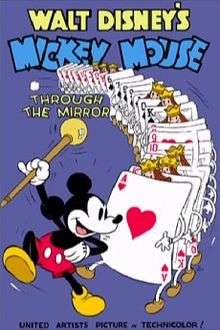Thru the Mirror
| Thru the Mirror | |
|---|---|
| Mickey Mouse series | |
 | |
| Directed by | David Hand |
| Produced by | Walt Disney |
| Story by |
William Cottrell Joe Grant |
| Voices by | Walt Disney |
| Music by |
Frank Churchill Leigh Harline Paul J. Smith |
| Animation by | Bob Wickersham |
| Studio | Walt Disney Productions |
| Distributed by | United Artists |
| Release date(s) | May 30, 1936 |
| Color process | Technicolor |
| Running time | 8 min (one reel) |
| Language | English |
| Preceded by | Mickey's Grand Opera (1936) |
| Followed by | Mickey's Rival (1936) |
Thru the Mirror is a Mickey Mouse cartoon short film produced by Walt Disney Productions, released by United Artists in 1936. In this cartoon short, Mickey has a Through the Looking-Glass-type dream that he travels through his mirror and enter a topsy-turvy world where everything is alive. While there, he engages in a Fred Astaire dance number with a pair of gloves and a pack of cards, until the cards chase him out of the bizarre world. The title is written as Thru the Mirror on the title card, but the alternative spelling Through the Mirror is used on the poster for the film.
Synopsis
Mickey falls asleep after reading Through the Looking-Glass by Lewis Carroll. An astral projection of himself (presumably Mickey in his dream state) leaves his body and passes through his mirror into an alternate version of his house. His furniture and possessions have come to life and are complete with faces and personalities, but most of them remain motionless. After dealing with a coat rack, a rocking chair and foot rest, an umbrella, and a nutcracker, Mickey eats a walnut and shrinks. He is now tiny and begins to dance his way through his house while the radio begins playing music, jump roping with the telephone, tap dancing on a top hat wearing a tiny one with a match for a cane, with some gloves, playing cards, and eventually the Queen of Hearts card (who resembles Greta Garbo). The joker, on his bicycle notices and alerts the King of Hearts who uses the joker's bike to get down there and fights for his lady in a sword duel with Mickey using both a sewing needle and a button as a makeshift sword. Mickey defeats the king by pushing him into an inkwell, where a stamp takes him out and cleans him. The king then orders for the cards to be called out and the radio acts as an alarm to summon the cards like police cars - "Calling all cards! Calling all cards!" in which some come out from the king's throne and some come out from a drawer. Chaos ensues and Mickey runs from the cards and blasts them with a fountain pen. He turns on an electric fan to blow the cards back, swings from a lamp rope, runs on a globe, grows back to his normal size, and escapes to the right side of the mirror where he reenters his body. Eventually he is awakened by his alarm clock and it has all been a dream, and goes back to sleep after throwing his alarm clock into a drawer.
Releases
- 1936 – theatrical release
- 1956 – Disneyland, episode #3.8: "The Plausible Impossible" (TV)
- c. 1972 – The Mouse Factory, episode #27: "Mickey Mouse" (TV)
- 1981 – "Mickey Mouse and Donald Duck Cartoon Collections Volume One" (VHS)
- c. 1983 – Good Morning, Mickey!, episode #4 (TV)
- c. 1992 – Mickey's Mouse Tracks, episode #52 (TV)
- 1997 – The Ink and Paint Club, episode #1.50: "Storyteller Mickey" (TV)
- 1998 – "The Spirit of Mickey" (VHS)
- 2001 – "Mickey Mouse in Living Color" (DVD)
- 2004/2011 – Bonus on DVD release of Alice in Wonderland (DVD)
- 2009 – Walt Disney Animation Collection: Mickey and the Beanstalk (DVD)
- 2011 – Have a Laugh!, episode #23 (TV)
- 2012 – Have a Laugh!: Volume 5 (DVD)
Trivia
- This cartoon was featured, and referenced, in the 2002 video game Disney's Magical Mirror Starring Mickey Mouse.
- Some elements from the cartoon like the cards and the opening were used in Epic Mickey.
- The song during the magic gloves dance scene was used for the Walt Disney Mini Classics promos during their movie's end.